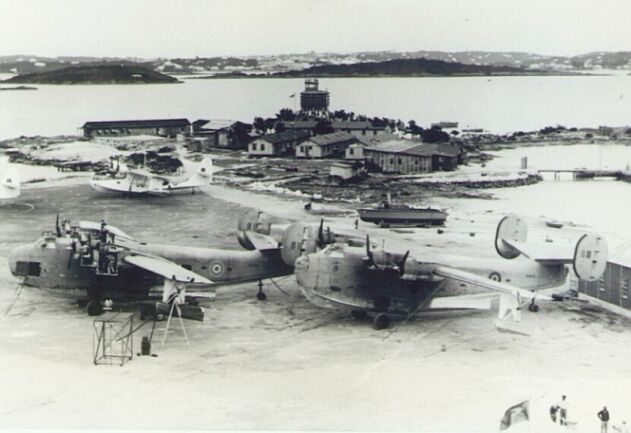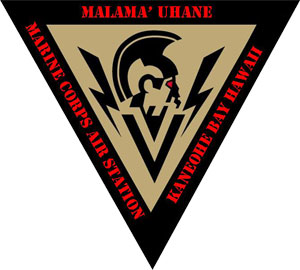|
VPB-100
VPB-100 was a Patrol Bombing Squadron of the U.S. Navy. The squadron was established as Patrol Squadron 100 (VP-100) on 1 April 1944, redesignated Patrol Bombing Squadron 100 (VPB-100) on 1 October 1944 and disestablished on 15 December 1945. Operational history *1 April 1944: VP-100 was established at NAS Kaneohe Bay, Hawaii, as a seaplane squadron flying the PBY-5 and PBY-5A Catalina. Personnel (seven officers and 15 enlisted) and equipment were drawn from the HEDRON Replacement Unit, FAW-2. The mission of the squadron was to train replacement crews, ferry aircraft to advance bases, and maintain two aircraft and one crew for around-the-clock standby and rescue work at NAS Kaneohe Bay. Detachments of two crews and two aircraft each were also maintained at Johnston Atoll and Kanton Island for rescue and Anti-submarine warfare (ASW) patrol duties. *15 July 1944: Lieutenant Cecil A. Roark and his PBY crew landed in heavy seas to rescue two survivors of an SB2C crash. The PBY was ... [...More Info...] [...Related Items...] OR: [Wikipedia] [Google] [Baidu] |
List Of Inactive United States Navy Aircraft Squadrons
There are hundreds of US Navy aircraft squadrons which are not currently active dating back to before World War II (the U.S. Navy operated aircraft prior to World War I, but it did not organize them in squadrons until after that war). To be more accurate: there are hundreds of former U.S. Navy aircraft squadrons which have been disestablished and no longer exist and there are approximately 40 or so U.S. Navy aircraft squadrons which have been deactivated and which currently exist only "on paper" in an inactive status. These disestablished and/or deactivated squadrons are sometimes incorrectly referred to as "decommissioned" squadrons, but proper usage prior to 1998, was that squadrons were "established" and "disestablished" and after 1998, squadrons are "established", "deactivated" and sometimes "reactivated". It has never been correct to refer to U.S. Navy aircraft squadrons as being "commissioned" and "decommissioned", ships are commissioned and decommissioned, U.S. Navy aircr ... [...More Info...] [...Related Items...] OR: [Wikipedia] [Google] [Baidu] |
List Of Squadrons In The Dictionary Of American Naval Aviation Squadrons
The tables below cover every one of the 280 squadrons listed in the U.S. Navy's two-volume ''Dictionary of American Naval Aviation Squadrons'' (''DANAS''). Volume 1 covers every squadron in the Attack (VA) and Strike Fighter (VFA) communities from 1935 to 1995. Volume 2 covers every squadron in the Patrol (VP) community from 1922 through 1996. You can see any squadron's ''DANAS'' article by following the link to the cited reference and scrolling down to the appropriate page. You can see its Wikipedia article by clicking the Wikilink in the table; if there is no Wikilink, there is no known article for the squadron. VA squadrons This table shows the 88 VA Attack Squadrons listed iVolume 1of ''DANAS''. A detailed lineage list for all squadrons mentioned in Volume 1 is availabl The articles for these squadrons are in the process of being renamed to parallel the names of articles in the other sections. For example, ''Third VA-34 (U.S. Navy)'' will become merely ''VA-34''. This is an ... [...More Info...] [...Related Items...] OR: [Wikipedia] [Google] [Baidu] |
Consolidated PB2Y Coronado
The PB2Y Coronado is a large flying boat patrol bomber designed by Consolidated Aircraft, and used by the US Navy during World War II in bombing, antisubmarine, and transport roles. Obsolete by the end of the war, Coronados were quickly taken out of service. Only one known example remains, at the National Naval Aviation Museum at Naval Air Station Pensacola, Florida. Design and development After deliveries of the PBY Catalina, also a Consolidated aircraft, began in 1935, the United States Navy began planning for the next generation of patrol bombers. Orders for two prototypes, the XPB2Y-1 and the Sikorsky XPBS-1, were placed in 1936; the prototype Coronado first flew in December 1937. After trials with the XPB2Y-1 prototype revealed some stability issues, the design was finalized as the PB2Y-2, with a large cantilever wing, twin tail with very marked dihedral, and four Pratt & Whitney R-1830 radial engines. The two inner engines were fitted with four-bladed reversible pitch p ... [...More Info...] [...Related Items...] OR: [Wikipedia] [Google] [Baidu] |
United States Department Of The Navy Seal
United may refer to: Places * United, Pennsylvania, an unincorporated community * United, West Virginia, an unincorporated community Arts and entertainment Films * ''United'' (2003 film), a Norwegian film * ''United'' (2011 film), a BBC Two film Literature * ''United!'' (novel), a 1973 children's novel by Michael Hardcastle Music * United (band), Japanese thrash metal band formed in 1981 Albums * ''United'' (Commodores album), 1986 * ''United'' (Dream Evil album), 2006 * ''United'' (Marvin Gaye and Tammi Terrell album), 1967 * ''United'' (Marian Gold album), 1996 * ''United'' (Phoenix album), 2000 * ''United'' (Woody Shaw album), 1981 Songs * "United" (Judas Priest song), 1980 * "United" (Prince Ital Joe and Marky Mark song), 1994 * "United" (Robbie Williams song), 2000 * "United", a song by Danish duo Nik & Jay featuring Lisa Rowe Television * ''United'' (TV series), a 1990 BBC Two documentary series * ''United!'', a soap opera that aired on BBC One from 1965-19 ... [...More Info...] [...Related Items...] OR: [Wikipedia] [Google] [Baidu] |
Kanton Island
Canton Island (also known as Kanton or Abariringa), previously known as Mary Island, Mary Balcout's Island or Swallow Island, is the largest, northernmost, and , the sole inhabited island of the Phoenix Islands, in the Republic of Kiribati. It is an atoll located in the South Pacific Ocean roughly halfway between Hawaii and Fiji. The island is a narrow ribbon of land around a lagoon; an area of . Canton's closest neighbour is the uninhabited Enderbury Island, west-southwest. The capital of Kiribati, South Tarawa, lies to the west. , the population was 20, down from 61 in 2000. The island's sole village is called Tebaronga. Kiribati declared the Phoenix Islands Protected Area in 2006, with the park being expanded in 2008. The marine reserve contains eight coral atolls, including Canton. Because it is inhabited, management of Canton Island is described in the Canton Resource Use Sustainability Plan (KRUSP), which covers a radius around the atoll. Over 50% of the island and lago ... [...More Info...] [...Related Items...] OR: [Wikipedia] [Google] [Baidu] |
History Of The United States Navy
The history of the United States Navy divides into two major periods: the "Old Navy", a small but respected force of sailing ships that was notable for innovation in the use of ironclads during the American Civil War, and the "New Navy" the result of a modernization effort that began in the 1880s and made it the largest in the world by 1943. The United States Navy claims October 13, 1775 as the date of its official establishment, when the Second Continental Congress passed a resolution creating the Continental Navy. With the end of the American Revolutionary War, the Continental Navy was disbanded. Under the Presidency of John Adams, merchant shipping came under threat while in the Mediterranean by Barbary pirates from four North African States. This led to the Naval Act of 1794, which created a permanent standing U.S. Navy. The original six frigates were authorized as part of the Act. Over the next 20 years, the Navy fought the French Republic Navy in the Quasi-War (1798� ... [...More Info...] [...Related Items...] OR: [Wikipedia] [Google] [Baidu] |
List Of United States Navy Aircraft Squadrons
This is a list of active United States Navy aircraft squadrons. ''Deactivated'' or ''disestablished'' squadrons are listed in the List of inactive United States Navy aircraft squadrons. Navy aircraft squadron (aviation), squadrons are composed of several aircraft (from as few as about four to as many as about a dozen), the officers who fly them, the officers and sailors who maintain them and administrative support officers and sailors. Some of the units listed in this article are not technically "squadrons", but they all operate U.S. Navy aircraft in some capacity. Squadrons and their history are listed in the ''Dictionary of American Naval Aviation Squadrons'' (DANAS). Squadron organization Active duty squadrons are typically Time commanded by a Commander (United States), commander. Second in command is the executive officer (XO), also a commander. The XO typically assumes command of the squadron after approximately 15 months. There are typically four functional departments – ... [...More Info...] [...Related Items...] OR: [Wikipedia] [Google] [Baidu] |
Maritime Patrol Aircraft
A maritime patrol aircraft (MPA), also known as a patrol aircraft, maritime reconnaissance aircraft, or by the older American term patrol bomber, is a fixed-wing aircraft designed to operate for long durations over water in maritime patrol roles — in particular anti-submarine warfare (ASW), anti-ship warfare (AShW), and search and rescue (SAR). Among other maritime surveillance resources, such as satellites, ships, unmanned aerial vehicles (UAVs) and helicopters, the MPA is an important asset. To perform ASW operations, MPAs typically carry air-deployable sonar buoys as well as torpedoes and are usually capable of extended flight at low altitudes. History First World War The first aircraft that would now be identified as maritime patrol aircraft were flown by the Royal Naval Air Service and the French Aéronautique Maritime during the First World War, primarily on anti-submarine patrols. France, Italy and Austria-Hungary used large numbers of smaller patrol aircraft for ... [...More Info...] [...Related Items...] OR: [Wikipedia] [Google] [Baidu] |
VPB-200
VPB-200 was a Patrol Bombing Squadron of the U.S. Navy. The squadron was established as Bombing Squadron Two Hundred (VB-200) on 1 April 1944, redesignated Patrol Bombing Squadron Two Hundred (VPB-200) on 1 October 1944 and disestablished on 24 October 1945. Operational history *1 April 1944: VB-200 was established at NAS Kaneohe Bay, Hawaii, as a combat replacement unit providing instruction on multiengine patrol aircraft. The personnel and equipment for the new squadron were drawn from the HEDRON Multiengine Replacement Unit, FAW-2. The squadron's primary duties included training replacement crews, ferrying aircraft and stand-by offshore patrol for Anti-submarine warfare and rescue work. Sections of the squadron operated on Johnston and Midway Atolls for rescue duties. Training squadrons like VB-200 trained fresh crews arriving from the U.S. in their final phases of combat training before being sent into the combat zone. VB-200 trained crews in land-based aircraft such as the P ... [...More Info...] [...Related Items...] OR: [Wikipedia] [Google] [Baidu] |
Curtiss SB2C Helldiver
The Curtiss SB2C Helldiver is a dive bomber developed by Curtiss-Wright during World War II. As a carrier-based bomber with the United States Navy (USN), in Pacific theaters, it supplemented and replaced the Douglas SBD Dauntless. A few survivors are extant. Initially poor handling characteristics and late modifications caused lengthy delays to production and deployment, to the extent that it was investigated by the Truman Committee, which turned in a scathing report. This contributed to the decline of Curtiss as a company. Neither pilots nor aircraft carrier skippers seemed to like it.Ethell 1995, p. 221. Nevertheless, the type was faster than the Dauntless, and by the end of the Pacific War, the Helldiver had become the main dive bomber and attack aircraft on USN carriers.Ethell 1995, p. 221. By the time a land-based variant, known as the A-25 Shrike, became available in late 1943, the Western Allied air forces had abandoned dedicated dive-bombers. A majority of A-25s deli ... [...More Info...] [...Related Items...] OR: [Wikipedia] [Google] [Baidu] |
Anti-submarine Warfare
Anti-submarine warfare (ASW, or in older form A/S) is a branch of underwater warfare that uses surface warships, aircraft, submarines, or other platforms, to find, track, and deter, damage, or destroy enemy submarines. Such operations are typically carried out to protect friendly shipping and coastal facilities from submarine attacks and to overcome blockades. Successful ASW operations typically involved a combination of sensor and weapon technologies, along with effective deployment strategies and sufficiently trained personnel. Typically, sophisticated sonar equipment is used for first detecting, then classifying, locating, and tracking a target submarine. Sensors are therefore a key element of ASW. Common weapons for attacking submarines include torpedoes and naval mines, which can both be launched from an array of air, surface, and underwater platforms. ASW capabilities are often considered of significant strategic importance, particularly following provocative instan ... [...More Info...] [...Related Items...] OR: [Wikipedia] [Google] [Baidu] |
NAS Kaneohe Bay
Marine Corps Air Station Kaneohe Bay or MCAS Kaneohe Bay is a United States Marine Corps (USMC) airfield located within the Marine Corps Base Hawaii complex, formerly known as Marine Corps Air Facility (MCAF) Kaneohe Bay or Naval Air Station (NAS) Kaneohe Bay. Most of the original contract work at Kaneohe had been completed when the Navy transferred what was undone to the Seabees of the 56th Naval Construction Battalion on 1 April 1943. The 112th CB was tasked with adding a second runway 400' x 5,000' to the airfield. That was completed by the men of the 74th CB. December 7, 1941, the Imperial Japanese Navy attacked the air station minutes prior to the attack on Pearl Harbor. Of the 36 Catalinas stationed here, 27 were destroyed and six others were damaged, along with 18 sailors who perished in the attack. The first Japanese aircraft destroyed in action were shot down at Kaneohe, along with Aviation Ordnanceman Chief Petty Officer John William Finn becoming one of the first Med ... [...More Info...] [...Related Items...] OR: [Wikipedia] [Google] [Baidu] |




.jpg)


